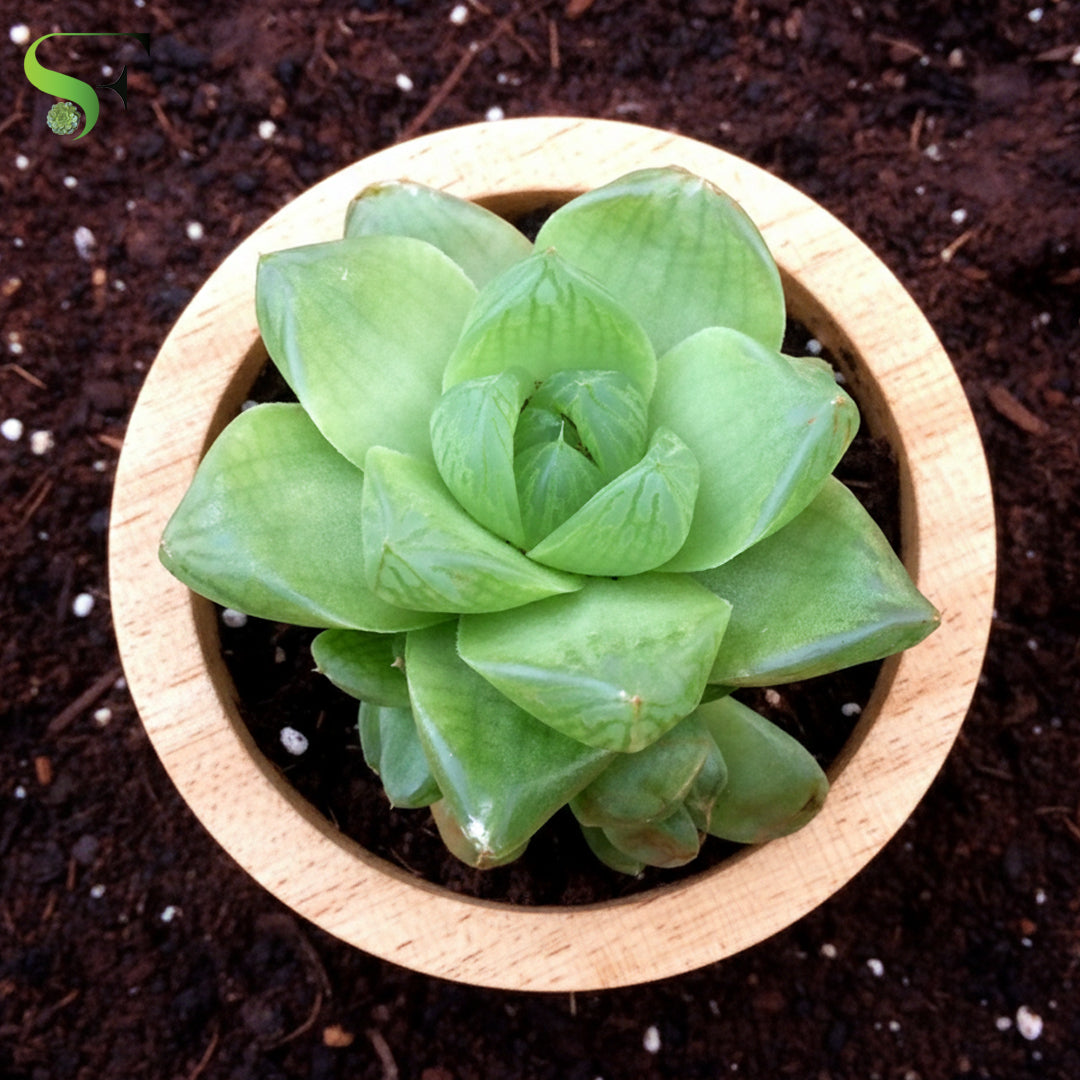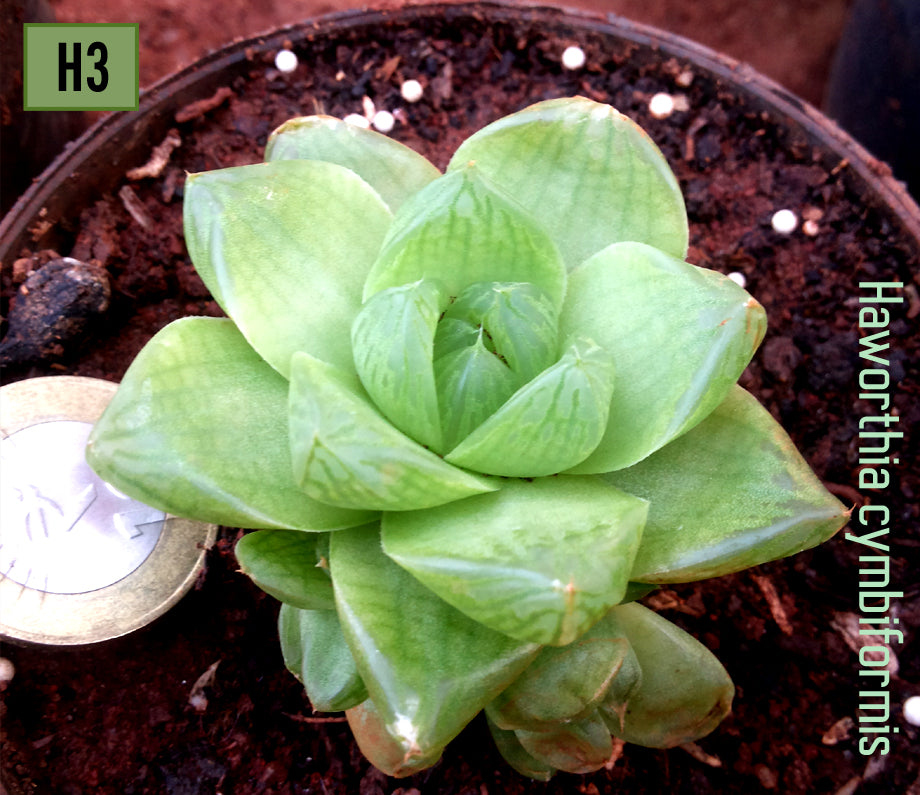Haworthia Cymbiformis - H3
Haworthia Cymbiformis - H3
Couldn't load pickup availability
ALL THE PLANTS WILL BE SENT BAREROOTED. NO POTS. NO SOIL
The Haworthia cymbiformis, often called "Cathedral Window Haworthia" or "Window Haworthia," is a charming and popular succulent known for its unique appearance and relatively easy care. It's a fantastic choice for both beginners and experienced succulent enthusiasts.
Detailed Description of Haworthia Cymbiformis
-
Appearance: This is a small, stemless, evergreen perennial succulent that forms compact rosettes of fleshy, boat-shaped leaves. The rosettes typically reach about 3-5 inches (8-13 cm) in diameter and 3 inches (8 cm) in height, though they can spread to cover a larger area over time as they produce offsets.
-
Leaves: The most striking feature of Haworthia cymbiformis is its leaves. They are usually light green, plump, turgid, and obovate (egg-shaped with the narrower end at the base). The tips of the leaves are famously translucent or "windowed," allowing light to penetrate for photosynthesis, especially in its natural habitat where it often grows under rocks or other vegetation. Some varieties may have finely toothed margins or dark longitudinal stripes towards the tip. When mildly stressed (e.g., from direct sun or drought), the leaves can develop a coppery flush.
-
Flowers: While not the main attraction, Haworthia cymbiformis produces delicate, small, white to very pale pink flowers with brownish-green veins. These are borne on slender, upright inflorescence stalks that can reach up to 8-12 inches (20-30 cm) tall. Flowering typically occurs in mid-spring to early summer.
-
Growth Habit: It has a clumping growth habit, readily producing offsets (pups) around the base of the mother plant. This allows it to form dense, mat-like clusters over time.
-
Origin: Native to the Eastern Cape Province of South Africa, it thrives in rocky, semi-arid regions, often growing in the shade of larger rocks or other plants. This natural habitat has equipped it with excellent drought tolerance.
-
Size: Individual rosettes typically remain small, making them ideal for small spaces, indoor container gardens, terrariums, or as desk plants.
-
Toxicity: Haworthia cymbiformis is non-toxic to pets and humans, making it a safe addition to homes with animals or children.
-
Growth Rate: These plants generally have a relatively slow growth rate, though this can be influenced by environmental factors like water availability and feeding.
Care and Growing Tips
Haworthia cymbiformis is considered a low-maintenance succulent, making it very suitable for beginners.
Water Requirements:
-
Infrequent but Thorough: Like most succulents, the most critical aspect of watering is to avoid overwatering, which can lead to root rot.
-
Allow Soil to Dry: Always allow the soil to dry out completely between waterings. You can check the top 1-2 inches of soil with your finger or a small stick; if it feels dry, it's time to water.
-
Deep Watering: When you do water, soak the soil thoroughly until water drains out of the drainage holes at the bottom of the pot. Ensure no excess water sits in the saucer.
-
Seasonal Adjustment: Water more frequently during the active growing season (spring and summer), typically every 2-3 weeks, depending on your climate and indoor conditions. Reduce watering significantly in fall and winter when the plant is dormant, often to once a month or even less.
-
Avoid Wetting Leaves: Try to water the soil directly at the base of the plant, avoiding getting water on the rosette, as moisture on the foliage can encourage fungal growth or rot.
-
Lukewarm Water: Using room temperature or lukewarm water is best to avoid shocking the roots.
Soil Requirement:
-
Well-Draining is Key: Excellent drainage is paramount for Haworthia cymbiformis to prevent waterlogging and root rot.
-
Gritty Mix: A standard succulent or cactus potting mix works well. These mixes are designed for good aeration and drainage.
-
DIY Mix: If you prefer to create your own, a good blend includes regular potting soil mixed with coarse sand, perlite, pumice, or other gritty materials. A common ratio is 50-70% mineral grit to 30-50% organic potting soil. Some growers even use 100% pumice or Akadama.
-
Drainage Holes: Always use pots with drainage holes. Without them, water can accumulate at the bottom, leading to root problems.
Sunlight:
-
Bright, Indirect Light: Haworthia cymbiformis prefers bright, indirect sunlight or filtered light. This mimics their natural habitat where they often grow under the partial shade of larger plants or rocks.
-
Morning Sun is Ideal: A spot near an east-facing window where it can receive gentle morning sun without the harshness of afternoon rays is perfect.
-
Avoid Intense Direct Sun: Prolonged direct afternoon sun can scorch the leaves, causing them to turn brown or purple, or become stressed.
-
Low Light Tolerance: One of the advantages of Haworthia is their ability to tolerate lower light conditions than many other succulents, making them excellent houseplants for various indoor settings. However, too little light can lead to etiolation (stretching and pale leaves).
-
Outdoor Placement: If grown outdoors, ensure they are in a location with morning sun and afternoon shade, or under a shade cloth.
Temperature and Humidity:
-
Temperature: Haworthia cymbiformis prefers temperatures between 60-85°F (15-29°C). They can tolerate brief periods of colder temperatures down to about 30°F (-1°C) but require protection from frost, which can severely damage or kill the plant. In colder climates (below USDA Zone 9-11), they should be brought indoors during winter.
-
Humidity: Average indoor humidity levels are generally sufficient. They prefer low to moderate humidity (30-50%). Avoid overly humid conditions, as this can encourage fungal growth.
Fertilization:
-
Minimal Feeding: Haworthia cymbiformis are not heavy feeders and generally do not require frequent fertilization.
-
During Growing Season: If you choose to fertilize, do so sparingly during the spring and summer growing season.
-
Diluted Fertilizer: Use a diluted (half-strength) balanced liquid fertilizer specifically formulated for succulents or cacti, once a month.
-
Avoid Dormancy: Do not fertilize during the fall and winter months when the plant is dormant. Over-fertilizing can lead to salt buildup in the soil.
Repotting:
-
When to Repot: Repot when the plant has outgrown its current pot, usually every 1-2 years, or when the cluster of offsets becomes too dense.
-
Timing: The best time for repotting is in spring or early summer.
-
Method: Choose a pot that is slightly larger and wide rather than deep, to accommodate their spreading roots. Use fresh, well-draining succulent potting mix. Gently remove the plant, clean off old soil, check roots for any rot (and trim if necessary), and repot.
Pests and Diseases:
-
Generally Resistant: Haworthia cymbiformis are relatively resistant to most pests and diseases.
-
Common Pests: Occasionally, they may encounter mealybugs (especially between leaves or on flower stalks), aphids on flower stalks, or root mealybugs. Slugs and snails can also be an issue if grown outdoors.
-
Pest Control: Treat pests with insecticidal soap or diluted rubbing alcohol. For root mealybugs, repotting with fresh soil and treating the roots can help.
-
Diseases: The most common issue is root rot, almost always caused by overwatering or poorly draining soil. Wilting and soft rot (where the plant turns black and rots from the inside) are signs of severe overwatering.
Propagation
Haworthia cymbiformis is remarkably easy to propagate, primarily through offsets, but also possible with leaf cuttings or seeds.
1. Offsets (Pups):
This is the easiest and most successful method.
-
Timing: Best done in spring or summer during the active growing season.
-
Separation: Gently remove the soil around the base of the mother plant to expose the offsets. Using a clean, sharp knife or scissors, carefully separate the offsets from the parent plant. Ensure each offset has some roots attached for better success.
-
Callous: If an offset doesn't have roots or if you've made a cut, allow the cut surface to "callous over" (dry and form a scab) for a few days to a week to prevent rot before planting.
-
Planting: Plant the separated offsets in their own small pots filled with a well-draining succulent mix.
-
Watering: Wait a few days to a week after planting before the first watering to allow any small wounds to heal. Then, water sparingly until the new plant establishes a strong root system.
2. Leaf Cuttings:
While possible, this method is more challenging and often less successful than offsets.
-
Selection: Choose a healthy, full leaf. The key is to ensure the base of the leaf, where it connects to the stem, remains intact, as this is where meristematic cells (which produce new growth) are located. Gently pull or carefully cut the leaf from the stem, ensuring a small piece of the stem tissue is attached.
-
Callous: Allow the leaf cutting to callous over for several days to a week in a dry, shaded place.
-
Planting: Place the calloused leaf cutting on top of or slightly inserted into a well-draining succulent soil mix.
-
Rooting: It can take weeks or even months for roots and new plantlets to form. Keep the soil slightly moist but not wet during this period. Lightly misting the soil surface can be beneficial. Avoid overwatering, as the leaf will be using its internal reserves.
-
Patience: Be patient! This method is slower and has a lower success rate compared to offsets.
3. Seeds:
Propagating from seeds is the most time-consuming method and generally only done by avid collectors or for breeding purposes.
-
Sowing: Sow seeds in a well-draining soil mix during spring. Lightly cover the seeds with sand or the same soil mix.
-
Moisture and Warmth: Keep the soil consistently moist (but not waterlogged) by covering the pot with plastic wrap to retain humidity. Place the pot in a warm, bright area, but out of direct sunlight.
-
Germination: Germination can be slow and sporadic.
Haworthia cymbiformis is a truly rewarding plant to grow, adding a unique texture and visual interest to any succulent collection with its distinctive windowed leaves.
Share




